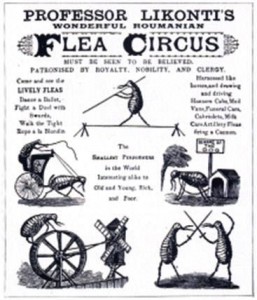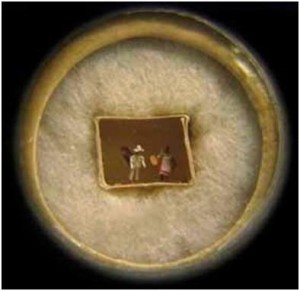Lisa Townley’s great grandmother’s bride and groom “pulgas vestidas” or dressed fleas.
One of the most unusual and interesting Ask A Worthologist questions that we have come across was posed by Lisa Townley, a WorthPoint member from Texas, regarding a small matchbox that contained miniature wedding dress and tuxedo—worn by a flea bride and groom. Lisa told me that she remembered the small box from when she was a child; she was told it had belonged to her great grandmother. Lisa further remembered that when she was a child, the flea groom had a top hat and the flea bride a veil, which have since disappeared. Oh, the things that people did for entertainment before radios, TV and computers. Women sewed and dressed these fleas in very elaborate costumes. One can only imagine the hours spent laboring on the itty-bitty costumes. It’s an unusual form of folk art that has all but disappeared, and I wonder who had the job to catch the fleas. Mike Wilcox, one of WorthPoint’s Generalists Worthologist, did the valuation for Lisa.
Dressed fleas from the Tring Museum.
“Flea brides and grooms (dressed, but dead) were popular collector’s items in the 1920s,” Mike reported. “In Mexico during that period you, might find “pulgas vestidas“—or “dressed fleas”—for sale. Fleas were dressed in tiny costumes. The history of flea art appears to have originated in Mexican convents, and was later taken up by the general tourist trade during the early 1900s.” There were also traveling shows, carnivals and flea circuses that went from town to town, where the audiences were amazed by that they saw. Or, might I say, what they thought they saw. Trained fleas were pulling and pushing objects much larger and many times the flea’s weight, as well as performing other amazing gymnastic triumphs. There were many tricks of the trade that gave the illusion of the fleas doing these tricks and performing. The curiosity for the flea circus died out in the 1930s, due to the general public’s increase knowledge of hygiene. The dressed fleas survived on as folk art souvenirs a while longer, until around the 1960s. To take a look at this short video to see a flea circus in action, watch this video.

A poster for Profesor Likonti's Flea Circus.
Mike Wilcox placed a fair market value for the dressed fleas at $75. The dressed fleas ranked a rare factor of 5 on our scale of 1 to 5, with 5 being most rare. Lisa’s wedding fleas remind me of one of the great pleasures of being a collector: to put yourself, if even for an instant, in the mind set of the people who created and treasured things long ago. Although we will never know who sat sewing these tiny costumes, we do know that flea circuses were bringing pleasure and entertainment to people as early as 1833, as they were advertised in England at that time. And we can imagine that the fleas belong to Lisa’s great grandmother, who probably took this little couple home, and kept them as a reminder of a very special trip to the circus. I always think how fortunate it is when family members hold on to special mementos and pass them on to younger generations. This is one of those little things that so easily could have been tossed away and forgotten about, but thanks to Lisa’s relatives, we all got a little look into the past. Dressing fleas belongs to a bygone era, but you can still see videos of flea circuses and how fleas are “trained” in the Internet. While the idea of flea circuses is fun and nostalgic, the way the insects w
 ere “trained” is a different and less-pleasant story. You can read about some of training techniques here. You can also find a list of current flea circus performers.
ere “trained” is a different and less-pleasant story. You can read about some of training techniques here. You can also find a list of current flea circus performers.









No comments:
Post a Comment